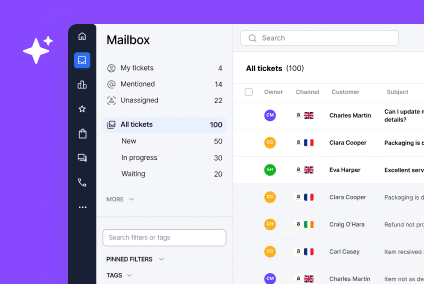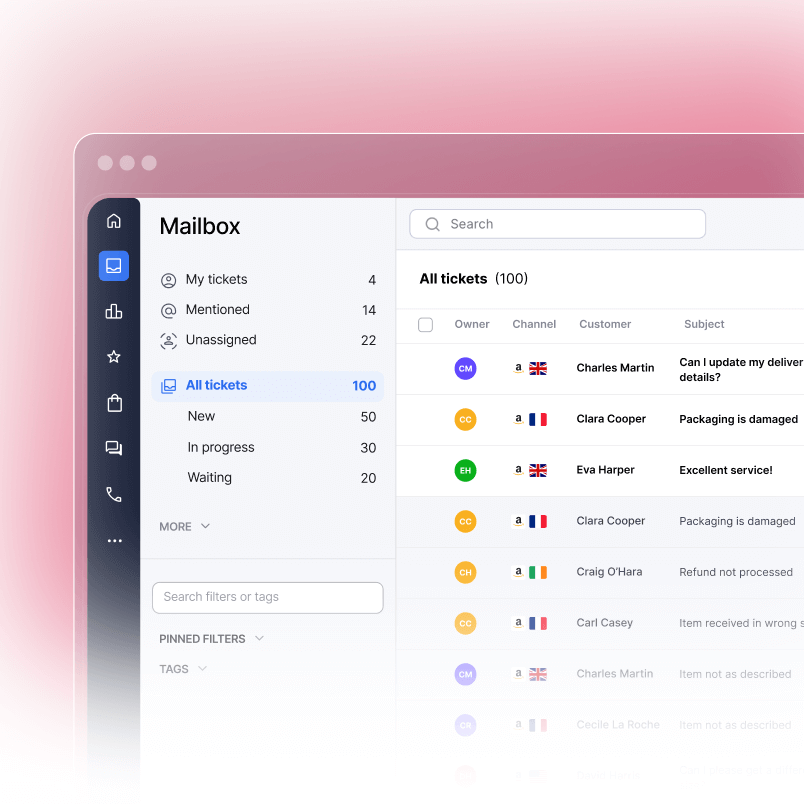Excellent customer service is an essential element to a positive buying experience.
When a customer needs help, the way you deal with the situation is often the difference between a five-star review and a complaint. But what defines great customer service?
It’s a tricky question, but one that you can answer with the help of customer service metrics.
Why you need customer service metrics
Customer service metrics enable you to measure, analyze and improve different areas of your customer service processes. If you can translate your customer service efforts into metrics, you’re able to create numerical benchmarks.
Measuring your customer service metrics against these benchmarks will inform you which areas you’re doing well in and which areas require some improvement.
Amazon requires strong customer service metrics
Jeff Bezos’s mission for Amazon is to create “Earth’s most customer-centric company.” It’s no surprise that they’re demanding when it comes to customer service metrics for sellers using their marketplace.
Take the requirements of a Seller Fulfilled Prime merchant as an example. To qualify for this status, your eCommerce customer service track record has to be impeccable, with 99% on-time shipping and a less than 1% cancellation rate.
Urban Surfer founder, Karl Smith, recognizes that this is one of its biggest challenges. “You need the right seller tools to help you hit those targets and make extra sales by reaching Amazon Prime customers.” maintains that a combination of great customer service and MFN Prime status will help the company double its turnover in a year.
It’s not just Seller Fulfilled Prime sellers that require high customer service metrics though. Every Amazon seller must respond to a customer query within the 24 hour SLA and failure to do so can result in account suspension!

9 top customer service metrics!
Perhaps you’re wondering where to start? Don’t worry, we’ve listed some of the most important customer service metrics so you can start measuring and optimizing today!
1. First response time
First response time or FRT is how long it takes a representative to get back to a customer.
How fast this should be will depend on the channel you’re measuring. For instance, you would measure a chatbot in seconds, but for email you’d be looking at hours.
Marketplaces demand rapid first response times to ensure a great customer experience.
Facebook offers businesses a ‘Very Responsive to Messages’ badge that sets companies apart from the competition. To achieve it, companies have to have an average response rate of 90% and average response time of five minutes or less over the past seven days.

As mentioned earlier, Amazon requires sellers to respond to a message within 24 hours and a return request withing 48 hours. Breaking this will jeopardize your seller privileges, so make sure you get it right!
One way to ensure you’re responding to messages as fast as possible is with an eCommerce customer service helpdesk like eDesk. Integrations with every major online marketplace in the world ensure you can respond to messages wherever they come from, on any channel, from a single inbox. This eliminates the need to go digging around in multiple programs to solve a problem.
Pro tip: The goal is always to solve a customer’s problem first time, but that’s not always possible. Simply keeping the customer updated and responding quickly dramatically increases satisfaction scores.
2. Average ticket resolution time
Average ticket resolution time is the average time taken to resolve a ticket from the moment of creation to closure. It’s also referred to as Mean Time To Resolve, or MTTR,
This customer service metric reveals all sorts of insights, from how well individual agents are performing, how comprehensive support systems are, to whether or not the department is under or over-staffed.
It’s a high level indicator that should be investigated in more detail if it stretches beyond acceptable levels. As mentioned, there are many factors that can contribute to a high average ticket resolution time.
Pro tip: Not all tickets are created equal. To get a true picture of performance, segment customer service issues by complexity. If you don’t, the time taken to resolve difficult inquiries will skew the picture of simple tasks.

3. Average tickets handled
Average tickets handled identifies how many queries an agent or department gets through during a defined period.
It’s important to explore all factors if an operative is getting through fewer tickets than expected. They may be focusing on more complex queries than most. They might not have enough access to customer data or could be lacking training.
Don’t forget to account for agents who were on holiday or sick during the assessment time!
Pro tip: If you’re using eDesk, your agents will be able to utilize one-click responses for common queries. This will free human resources up to deal with more complex queries.
4. Issue resolution rate
Issue resolution rate is the percentage of resolved tickets against the total tickets received by an agent.
This customer service metric helps you see which agents might need more support to resolve customer queries. It can also identify highly effective agents and is useful when measured alongside average tickets handled.
With eDesk, customer support agents are able to tag in a colleague to help them resolve a query. If an agent is struggling with issue resolution, try to encourage them to use this feature!
eDesk can also automatically route tickets to the most appropriate agent. For example, if you have a native French speaker, you can set rules for all incoming tickets from Amazon France to be assigned to him/her. This makes collaboration seamless and greatly improves issue resolution rate.
Pro tip: The issue resolution rate is only the starting point for investigations. One agent may have more open tickets than another but their customer satisfaction rating or net promoter score may be higher. They could be spending longer on higher-value customers, thus securing better future revenue for the company.
5. Negative feedback rate
Your negative feedback rate is the percentage of your customers that leave a negative review. This customer service metric should be as low as possible!
Negative reviews don’t just turn off potential customers, they impact your products’ visibility. Ratings have a significant impact on Google’s ranking algorithm, which translates into the traffic for your online store.
On Amazon, they contribute to the Order Defect Rate (ODR) which must remain below 1% for a seller to remain on the site. Negative feedback counts as one or two-star reviews.
Negative ratings and feedback has a detrimental effect on your products’ rankings on eBay as well. The Best Match algorithm considers sellers with high levels of positive feedback to be more relevant and therefore pushes them higher in the rankings.
The best merchants are awarded eBay stars based on their levels of positive feedback. This is designed to reassure buyers that they’re dealing with a reputable merchant. Keep your negative feedback rate down and you’ll be shooting up the rankings in no time!
Pro tip: Try everything you can to remove negative feedback on eBay and Amazon. There may be circumstances that these reviews can be struck from the record!
6. Rate of positive reviews
The rate of positive reviews is simply the percentage of your customers that leave a positive review.
There is no doubting the power of the review, with 90% of consumers making a purchasing decision having read 10 or fewer. However, it’s not just having positive reviews that matter, but how many and how recent.
Online shoppers look for a consistently high volume of positive reviews over time. Make sure reviews are visible on your product pages to increase conversion levels!
Be careful to build reviews the right way. If your company has a flurry of reviews over a short period, then this looks suspicious and you could erode consumer confidence.
In addition, online marketplaces such as Amazon and eBay are very quick to identify fake or incentivized reviews, so make sure you always follow the rules!
Pro tip: Proactively encourage reviews as an ongoing strategy. Nearly three-quarters (71%) of consumers will leave a review if asked to.

7. Net promoter score
The Net Promoter Score (NPS) score is determined by the percentage of promoters minus the percentage of detractors. This is based on a scale of 0-10, where customers on the 0-6 scale are detractors and 9-10 are promoters with passives in between.
Companies with long-term profitability tend to have double the net promoter score of their competitors. You certainly shouldn’t overlook this customer service metric!
Pro tip: Identifying and working with your promoters to turn them into advocates who leave reviews and testimonials increases customer retention, and every 5% increase in retention can increase profits by 25%.
8. Repeat sales
This customer service metrics simply indicates additional sales from existing customers. You can use it as a figure, value or as a percentage.
Customers coming back to buy more is always a strong indicator of satisfaction and the higher the percentage of repeat sales, the higher customer confidence maybe.
You should consider these differently depending on the sector your selling in. For example, if you’re selling fast moving consumer goods (FMCG), you should expect higher repeat sales than products designed to last several years.
Identifying repeat purchasers and targeting them with specific messaging (“Thank you for shopping with us again!”) reinforces the relationship and encourages not just further purchasing but potentially increases basket size. Customers who make multiple repeat purchases are much more valuable than those who have only returned once or twice.
Pro tip: Why not use your eCommerce packaging to encourage repeat sales? You could include a picture of a related product or maybe a small sample.

9. Rate of cross-sell and rate of up-sell
This metric is the percentage of customers that proceed to buy a different product or a more expensive version of what they’ve previously purchased.
Similar to repeat sales, a higher percentage of customers buying into different or more expensive product lines shows a greater affinity and loyalty to your brand, while also indicating that customer service activities are doing a good job of supporting the business.
Low cross and up-selling rates don’t necessarily mean the brand is under-performing or demonstrating poor customer experience. It could be that you’re simply missing opportunities to ask or put the opportunity in front of customers.
Final words
Each of these customer service metrics provides vital insight into the effectiveness of your customer service operation.
However, there’s a danger in looking at them in isolation. Instead, you should view them alongside each other. Only then will you be able to see the complete picture of your eCommerce customer service operation and improve it!
With an eCommerce helpdesk, like eDesk, you’ll be able to easily measure all of your customer service metrics from every channel you sell on. Whether you’re responding to customers on social media, email, or marketplace messages, eDesk simplifies every aspect of eCommerce customer service.




